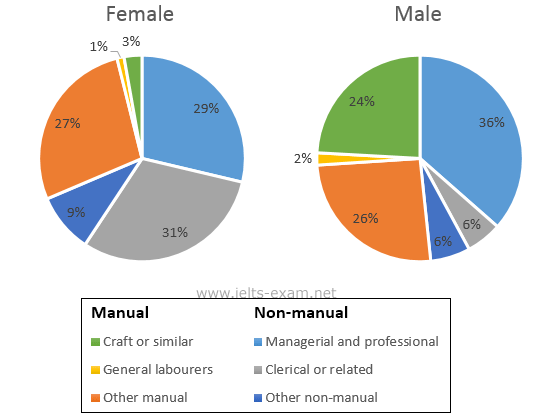The pie charts compare the proportion of six selected employment patterns both man and woman in Great Britain in 1992. Overall, the highest employment pattern was seen on the proportion of managerial and professional for both man and woman's figure.
Managerial and professional field tended to be popular in both gender. It reached almost less than a third for woman's cohort and more than a third for man's figure. Clerical or related and other non-manual employment were less popular among male employees. It was proved by only at 6% for both brackets. By contrast, woman's figure showed different trend. Woman's figure saw 5 times higher than man's figure for clerical or related employment, while it was standing at 9% for other non-manual field.
In contrast, general labourers shared the lowest proportion of all employment patterns. It was only 1% and 2% for female and male's figures. Woman employees worked in other manual field standing at 27% followed by man's cohort at 26%, respectively. However, a very small number of woman worked in craft or similar field, while man's figure experienced 8 times higher than woman's figure.
Managerial and professional field tended to be popular in both gender. It reached almost less than a third for woman's cohort and more than a third for man's figure. Clerical or related and other non-manual employment were less popular among male employees. It was proved by only at 6% for both brackets. By contrast, woman's figure showed different trend. Woman's figure saw 5 times higher than man's figure for clerical or related employment, while it was standing at 9% for other non-manual field.
In contrast, general labourers shared the lowest proportion of all employment patterns. It was only 1% and 2% for female and male's figures. Woman employees worked in other manual field standing at 27% followed by man's cohort at 26%, respectively. However, a very small number of woman worked in craft or similar field, while man's figure experienced 8 times higher than woman's figure.

The Pie Charts
